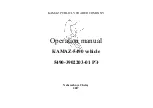
For example, your vehicle may have a recommended
cold (parked for more than three hours) placard
pressure of 30 psi (207 kPa). If the ambient
temperature is 68°F (20°C) and the measured tire
pressure is 27 psi (186 kPa), a temperature drop
to 20°F (-7°C) will decrease the tire pressure to
approximately 23 psi (158 kPa). This tire pressure is
sufficiently low enough to turn on the TPMS Warning
Light. Driving the vehicle may cause the tire pressure
to rise to approximately 27 psi (186 kPa), but the
TPMS Warning Light will still be on. In this situation,
the TPMS Warning Light will turn off only after the tires
are inflated to the vehicle’s recommended cold placard
pressure value.
CAUTION!
●
The TPMS has been optimized for the original
equipment tires and wheels. TPMS pressures and
warning have been established for the tire size
equipped on your vehicle. Undesirable system
operation or sensor damage may result when
using replacement equipment that is not of the
same size, type, and/or style. Aftermarket wheels
can cause sensor damage.
●
Using aftermarket tire sealants may cause the
Tire Pressure Monitoring System (TPMS) sensor
to become inoperable. After using an aftermarket
tire sealant it is recommended that you take your
vehicle to an authorized dealership to have your
sensor function checked.
●
After inspecting or adjusting the tire pressure
always reinstall the valve stem cap. This will
prevent moisture and dirt from entering the valve
stem, which could damage the TPMS sensor.
NOTE:
●
The TPMS is not intended to replace normal tire
care and maintenance or to provide warning of a tire
failure or condition.
●
The TPMS should not be used as a tire pressure
gauge while adjusting your tire pressure, unless your
vehicle is equipped with a Tire Fill Alert (TFA) system.
●
Driving on a significantly underinflated tire causes
the tire to overheat and can lead to tire failure.
Underinflation also reduces fuel efficiency and tire
tread life, and may affect the vehicle’s handling and
stopping ability.
●
The TPMS is not a substitute for proper tire
maintenance, and it is the driver’s responsibility to
maintain correct tire pressure using an accurate
tire pressure gauge, even if underinflation has not
reached the level to trigger illumination of the TPMS
Warning Light.
●
Seasonal temperature changes will affect tire
pressure, and the TPMS will monitor the actual tire
pressure in the tire.
Tire Pressure Monitoring System Display
The Tire Pressure Monitoring System (TPMS) uses
wireless technology with wheel rim mounted electronic
sensors to monitor tire pressure levels. Sensors,
mounted to each wheel as part of the valve stem,
transmit tire pressure readings to the receiver module.
NOTE:
It is particularly important for you to check the tire
pressure in all of the tires on your vehicle monthly and
to maintain the proper pressure.
The TPMS consists of the following components:
●
Receiver module
●
Four Tire Pressure Monitoring System sensors
●
Various Tire Pressure Monitoring System messages,
which display in the instrument cluster
●
Tire Pressure Monitoring System Warning Light
Tire Pressure Monitoring System Low
Pressure Warnings
The Tire Pressure Monitoring System
(TPMS) Warning Light will illuminate in the
instrument cluster and a chime will sound
when tire pressure is low in one or more of
the four active road tires. In addition, the instrument
cluster will display a graphic showing the pressure
values of each tire with the low tire pressure values
in a different color. An "Inflate to XX" message will also
be displayed.
250 SAFETY



































